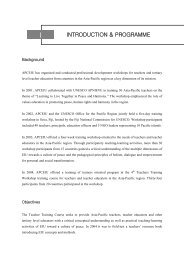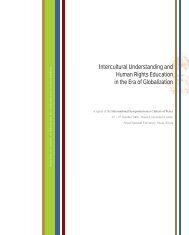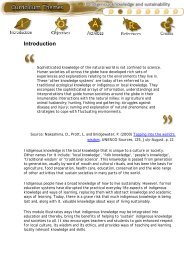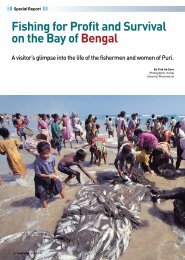REPORT OF UNESCO EXPERT MEETING ON - APCEIU
REPORT OF UNESCO EXPERT MEETING ON - APCEIU
REPORT OF UNESCO EXPERT MEETING ON - APCEIU
You also want an ePaper? Increase the reach of your titles
YUMPU automatically turns print PDFs into web optimized ePapers that Google loves.
Overall conclusions<br />
The richness and diversity of these traditions and the many ways in which they embody notions of stewardship<br />
of nature are very striking. However, despite the individual differences, the focus group interviews and surveys<br />
yielded remarkably consistent pattern in the findings about the environmental awareness, knowledge, beliefs<br />
and behaviour of young people across the region. These findings have important implications for<br />
environmental education policy and curriculum development.<br />
First, as might be expected, awareness and knowledge of individual environmental concepts vary considerably.<br />
Nevertheless it could be said that there is at least some awareness in every country of all the concepts<br />
discussed in the research. These concepts included: the carbon cycle, sustainable development, biodiversity,<br />
renewable resources, ecology, intergenerational equity, the precautionary principle, the greenhouse effect,<br />
ozone layer depletion and carrying capacity. Even the least known concepts, intergenerational equity and the<br />
precautionary principle, were known to at least 20% of students in all countries. However, those concepts that<br />
were less discipline-specific and more sustainable development related – the newer ones – were far less well<br />
known and understood perhaps a sign of curricula in most countries failing to keep up to date with<br />
developments in national policy<br />
Second, young people recognise environmental problems as real and significant and are knowledgeable and<br />
concerned about a wide range of local, national and global problems. However, questions can be asked about<br />
the depth of understanding that lies beneath these high levels of awareness. For example, in every country the<br />
destruction of the ozone layer was seen as the most important environmental issue facing the world. Yet, this is<br />
one of the very few global problems that international action seems to have solved, although recovery to pre-<br />
1980 levels is not expected until around 2050. Probing this situation might lead to several questions. Are<br />
students’ misunderstandings due to incomplete teaching, inadequate educational resources or, perhaps, the<br />
tendency for environmental courses to focus on problems rather than solutions and success stories?<br />
Third, environmental beliefs are widely shared by young people across all countries despite differences in local<br />
cultural traditions, environmental situations and education systems. The great majority of students in all the<br />
countries in the study expressed strongly environmentally supportive views and beliefs. It could therefore be<br />
said that young people in all countries have moved decisively towards the adoption of an environmental<br />
paradigm. Interestingly, the young people generally believed that while protecting the environment is more<br />
important than economic growth, it is possible to have both a healthy environment and a prosperous economy.<br />
However, they do not seem to have a sound understanding of the relationships between social, economic and<br />
institutional frameworks, and ecological degradation and sustainability.<br />
This may be because the young people in every country said that the media, particularly television, was their<br />
major source of environmental information, followed by schools, whose contribution was often regarded as<br />
more reliable but also more boring. Increased attention to the humanities (especially media literacy) and the<br />
28








